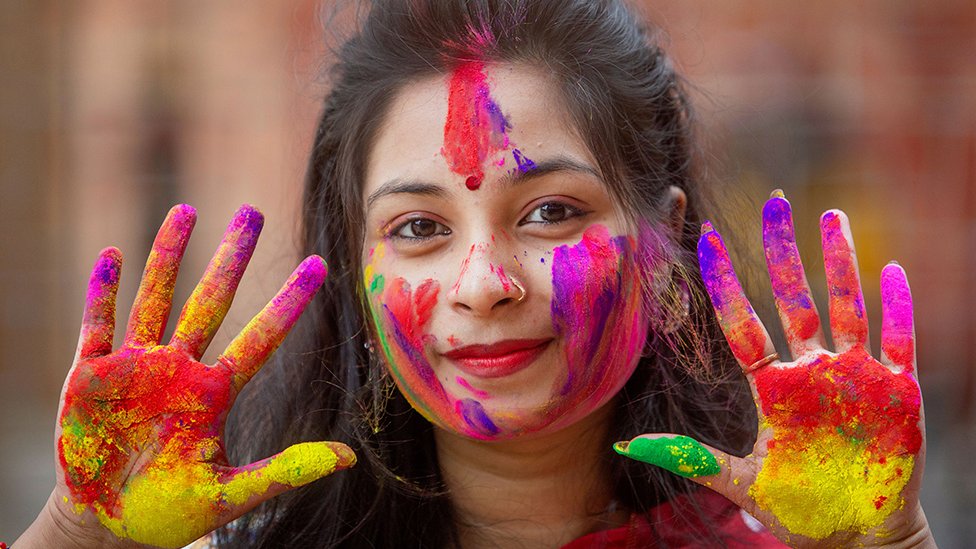Holi: The Festival of Colors and Joy
Introduction
Holi, often referred to as the “Festival of Colors,” is one of the most vibrant and joyful celebrations in India and around the world. It is a festival that marks the arrival of spring, the end of winter, and the blossoming of love. Holi is a time when people come together to celebrate life, love, and the triumph of good over evil. With its rich history, deep cultural significance, and colorful traditions, Holi is not just a festival but a celebration of the very essence of life.
The festival of Holi is celebrated with great enthusiasm and zeal across India and in many parts of the world where the Indian diaspora resides. It is a time when people from all walks of life come together to forget their differences, embrace each other, and revel in the spirit of unity and joy. Holi is a festival that transcends religious and social boundaries, bringing people together in a spirit of camaraderie and harmony.
This essay delves into the origins, cultural significance, traditions, and modern-day celebrations of Holi. It also explores the festival’s impact on society and the environment, as well as the way it is celebrated in different parts of the world.
Origins and Historical Significance of Holi
The origins of Holi can be traced back to ancient Hindu mythology and religious texts. The festival is deeply rooted in the cultural and spiritual traditions of India and has been celebrated for thousands of years. One of the most popular legends associated with Holi is the story of Prahlad and Hiranyakashipu, which symbolizes the victory of good over evil.
According to Hindu mythology, Hiranyakashipu was a powerful demon king who was granted a boon that made him virtually indestructible. He became arrogant and demanded that everyone in his kingdom worship him as a god. However, his own son, Prahlad, was a devout follower of Lord Vishnu and refused to worship his father. This enraged Hiranyakashipu, who tried to kill Prahlad several times but failed due to the protection of Lord Vishnu.
Finally, Hiranyakashipu sought the help of his sister, Holika, who had a magical cloak that made her immune to fire. Holika tricked Prahlad into sitting on her lap in a blazing fire, thinking that the cloak would protect her while Prahlad would perish. However, due to Prahlad’s unwavering devotion to Lord Vishnu, the cloak flew off Holika and covered Prahlad instead, saving him from the flames while Holika was burned to ashes. This event is celebrated as Holika Dahan, which takes place on the eve of Holi. It symbolizes the triumph of good over evil and the power of devotion and faith.
Another legend associated with Holi is the story of Lord Krishna and Radha. Lord Krishna, known for his playful and mischievous nature, was concerned about his dark complexion and wondered whether Radha, his beloved, would accept him. His mother, Yashoda, suggested that he apply color to Radha’s face and see how she would react. Krishna playfully applied color to Radha’s face, and she reciprocated, leading to a joyous celebration of love and togetherness. This legend is believed to be the origin of the tradition of playing with colors during Holi.
In addition to these legends, Holi is also associated with the harvest season. In many parts of India, the festival marks the end of the winter crop and the beginning of the spring harvest. It is a time of thanksgiving and celebration, as farmers rejoice in the abundance of the harvest and pray for a prosperous year ahead.
Cultural Significance of Holi
Holi is a festival that holds deep cultural significance in India and among Hindus around the world. It is a time when people come together to celebrate the values of love, unity, and harmony. The festival transcends religious and social boundaries, bringing people of all ages, backgrounds, and communities together in a spirit of joy and togetherness.
One of the central themes of Holi is the celebration of the triumph of good over evil. The story of Prahlad and Hiranyakashipu serves as a powerful reminder of the importance of faith, devotion, and righteousness. It is a message that resonates with people across cultures and religions, reminding us that good will always prevail over evil, no matter how powerful the forces of darkness may seem.
Holi is also a celebration of love and the bonds of friendship and family. The playful exchange of colors during the festival is a way of expressing love, affection, and goodwill towards others. It is a time when people forgive past grievances, mend broken relationships, and strengthen the bonds of friendship and family. The festival encourages people to let go of their differences and come together in a spirit of unity and harmony.
The festival of Holi also holds agricultural significance, as it marks the end of the winter crop and the beginning of the spring harvest. It is a time when farmers celebrate the abundance of the harvest and pray for a prosperous year ahead. In this sense, Holi is also a celebration of nature and the cycles of life, reminding us of the importance of living in harmony with the natural world.
Traditions and Rituals of Holi
Holi is celebrated with a variety of traditions and rituals, each of which holds its own significance. The festival typically lasts for two days, with the first day known as Holika Dahan or Chhoti Holi, and the second day known as Rangwali Holi, Dhulandi, or Phagwah.
Holika Dahan
The festivities begin on the evening of Holika Dahan, which is also known as Chhoti Holi. On this day, people gather around large bonfires to commemorate the burning of the demoness Holika and the victory of good over evil. The bonfire, known as the Holika pyre, is typically made of wood, dried leaves, and other combustible materials. People also burn old items, symbolizing the destruction of evil and the cleansing of negative energies.
Before the bonfire is lit, a small puja (prayer) is performed to seek blessings and protection from evil forces. People offer grains, coconuts, and other offerings to the fire as a sign of gratitude and thanksgiving. Once the fire is lit, people sing and dance around the bonfire, celebrating the victory of good over evil.
The ashes from the bonfire are considered sacred and are often collected by devotees to be smeared on their foreheads as a mark of protection and blessing. In some communities, people take embers from the bonfire to their homes to relight their hearths, symbolizing the renewal of life and the beginning of a new year.
Rangwali Holi
The second day of Holi, known as Rangwali Holi, is the most joyous and colorful part of the festival. On this day, people gather in open spaces, streets, and parks to play with colors, sing, dance, and celebrate with abandon. The air is filled with the vibrant hues of gulal (colored powder) and the sounds of laughter, music, and merriment.
The tradition of playing with colors during Holi is believed to have its origins in the legend of Lord Krishna and Radha. The exchange of colors is a way of expressing love, joy, and togetherness. People throw colored powders and water at each other, drenching themselves and others in a riot of colors. It is a time when social barriers are broken down, and people of all ages, backgrounds, and communities come together to celebrate in a spirit of unity and equality.
In addition to playing with colors, people also sing traditional Holi songs, known as “Phag” or “Hori,” which are often accompanied by drums and other musical instruments. The songs are typically light-hearted and playful, reflecting the joyous and carefree spirit of the festival.
Food is an integral part of the Holi celebrations, and special dishes are prepared to mark the occasion. One of the most popular Holi delicacies is “gujiya,” a sweet pastry filled with a mixture of khoya (thickened milk) and dry fruits. Other traditional Holi foods include “thandai,” a refreshing drink made with milk, almonds, and spices, and “bhang,” a cannabis-infused drink that is traditionally consumed during the festival.
In many parts of India, Holi is also a time for social gatherings and community events. People visit the homes of friends and family, exchange sweets and gifts, and share in the festivities. It is a time for renewing bonds, mending relationships, and spreading joy and goodwill.
Regional Variations in Holi Celebrations
While Holi is celebrated across India, the way the festival is observed can vary significantly from one region to another. Each region has its own unique traditions and customs that add to the diversity and richness of the festival.
Holi in North India
In North India, particularly in the states of Uttar Pradesh, Haryana, Punjab, and Rajasthan, Holi is celebrated with great enthusiasm and fervor. The festival is marked by large gatherings, street processions, and vibrant displays of colors. In the city of Mathura, which is believed to be the birthplace of Lord Krishna, Holi is celebrated with special significance. The celebrations in Mathura and the neighboring town of Vrindavan can last for more than a week, with various events and rituals taking place, including the famous “Lathmar Holi,” where women playfully beat men with sticks while they try to shield themselves with shields.
In Haryana, a unique tradition known as “Dhulandi” is observed, where brothers visit their married sisters and bring them gifts. The sisters, in turn, greet their brothers with colors and sweets, symbolizing the bond of love and protection between siblings.
In Rajasthan, Holi is celebrated with the same exuberance, but the festivities often include folk dances, music, and traditional Rajasthani cuisine. In the royal city of Udaipur, the Maharana of Mewar organizes a grand procession through the streets, followed by a bonfire and cultural performances at the City Palace.
Holi in West Bengal
In the state of West Bengal, Holi is known as “Dol Jatra” or “Dol Purnima” and is celebrated with a mix of religious and cultural traditions. The festival is closely associated with the worship of Lord Krishna and Radha, and the rituals include singing devotional songs, dancing, and swinging idols of the deities on decorated swings.
In the town of Shantiniketan, which was founded by the Nobel laureate Rabindranath Tagore, Holi is celebrated as “Basant Utsav” or the “Festival of Spring.” The celebrations are marked by cultural programs, including traditional Bengali music, dance, and poetry recitals. The students and faculty of Visva-Bharati University, which was established by Tagore, participate in the festivities by playing with colors and performing traditional dance and music.
Holi in Maharashtra
In Maharashtra, Holi is celebrated with the same zeal and enthusiasm as in North India, but the festival also has a strong association with the agricultural community. The festival marks the end of the Rabi crop season, and farmers celebrate the occasion by offering their first harvest to the gods and performing rituals to ensure a bountiful harvest in the coming year.
One of the unique traditions in Maharashtra is the celebration of “Shigma,” which is a variation of Holika Dahan. The bonfire is lit in the evening, and people gather around it to sing, dance, and celebrate the victory of good over evil.
In the city of Mumbai, Holi is celebrated with grand parties, music, and dance. Many Bollywood celebrities also host Holi parties, which are attended by people from the film industry and beyond.
Holi in South India
In South India, Holi is not as widely celebrated as in the North, but it is observed with its own unique customs and traditions. In the state of Karnataka, the festival is known as “Kama Dahanam” and is associated with the legend of Kamadeva, the god of love. According to mythology, Kamadeva was burned to ashes by Lord Shiva when he tried to disturb Shiva’s meditation. Holi is celebrated as a way of honoring Kamadeva and his sacrifice for love.
In Tamil Nadu, Holi is known as “Kaman Pandigai” and is celebrated with rituals that involve the burning of effigies of Kamadeva, followed by singing and dancing. In some parts of Kerala, Holi is celebrated as “Manjal Kuli,” where people play with turmeric water instead of colored powders.
Holi in Gujarat
In Gujarat, Holi is celebrated with a combination of religious rituals and cultural festivities. The festival is marked by the lighting of the Holika pyre, followed by the playing of colors and the singing of traditional Gujarati folk songs. In some parts of the state, people also perform the “Dandiya Raas” and “Garba” dances, which are traditional Gujarati dance forms.
In the city of Ahmedabad, a unique tradition known as “Bhogi” is observed, where people light bonfires early in the morning and perform rituals to ward off evil spirits and negative energies.
Holi in Goa
In the state of Goa, Holi is known as “Shigmo” and is celebrated with a blend of Hindu and Christian traditions. The festival is marked by colorful parades, street processions, and cultural performances. The celebrations in Goa also include the playing of traditional Goan folk music and dance, as well as the consumption of special Goan delicacies.
Environmental Impact of Holi
While Holi is a festival of joy and celebration, it is important to recognize the environmental impact of the festivities, particularly the use of synthetic colors and the burning of large bonfires. In recent years, there has been a growing awareness of the need to celebrate Holi in an eco-friendly manner, and many people are adopting practices that reduce the environmental impact of the festival.
One of the primary concerns is the use of synthetic colors, which often contain harmful chemicals and toxins that can cause skin allergies, respiratory problems, and environmental pollution. To address this issue, many people are now opting for natural and organic colors made from flowers, herbs, and other natural ingredients. These eco-friendly colors are not only safer for human health but also less harmful to the environment.
Another environmental concern is the burning of large bonfires during Holika Dahan, which can contribute to air pollution and deforestation. To mitigate this impact, some communities are adopting alternative practices, such as the use of smaller bonfires made from agricultural waste or the planting of trees as a symbolic gesture of renewal and growth.
In addition to these practices, there is also a growing movement towards celebrating a “dry Holi,” where people play with colors without the use of water. This helps conserve water, which is a precious resource in many parts of India, particularly during the dry season.
Global Celebrations of Holi
Holi is not only celebrated in India but has also gained popularity in many parts of the world, particularly in countries with a significant Indian diaspora. The festival is celebrated with the same enthusiasm and spirit of joy, with people from different cultural backgrounds coming together to participate in the festivities.
In countries like Nepal, Holi is celebrated as a national festival, with people gathering in the streets to play with colors and sing traditional songs. The celebrations in Nepal are similar to those in India, with the exchange of colors, sweets, and greetings.
In the United States, Holi has become a popular cultural event, particularly in cities with large Indian communities. Many universities, cultural organizations, and temples organize Holi celebrations, where people of all ages and backgrounds come together to celebrate with colors, music, and dance. The festival has also been embraced by non-Indians, who participate in the festivities as a way of experiencing Indian culture and traditions.
In the United Kingdom, Holi is celebrated with great enthusiasm, particularly in cities like London, Leicester, and Birmingham. The celebrations often include cultural performances, food stalls, and the playing of colors, with people coming together to celebrate in a spirit of unity and harmony.
Holi is also celebrated in other countries such as Canada, Australia, South Africa, and Trinidad and Tobago, where the Indian diaspora has a strong presence. The festival has become a way for people to connect with their cultural roots and share their traditions with the wider community.
Conclusion
Holi is a festival that embodies the spirit of joy, love, and togetherness. It is a celebration of life, the triumph of good over evil, and the renewal of hope and happiness. The vibrant colors, lively music, and joyous celebrations make Holi a festival like no other, bringing people together in a spirit of unity and harmony.
As we celebrate Holi, it is important to remember the values and traditions that the festival represents. It is a time to let go of past grievances, embrace each other with love and goodwill, and celebrate the bonds of friendship and family. It is also a time to reflect on the importance of living in harmony with nature and taking steps to protect our environment.
In a world that is often divided by differences, Holi serves as a reminder of the power of love, unity, and togetherness. It is a festival that transcends boundaries, bringing people of all cultures and backgrounds together in a celebration of life and joy. As we look to the future, let us carry the spirit of Holi with us, spreading love, happiness, and peace wherever we go.



